Every day, dozens, and sometimes even hundreds, of different digital products are being developed: mobile apps, websites, PWAs, SPAs, and complex web systems. They are made to fulfill particular business requirements and cater to their target audience for monetization and other goals. By the way, web development is a fairly common but not dominant type of service.
Market Research Guru analysts say the web development market was estimated at over $60 billion as of 2022. According to the same source's forecasts, by 2028, the industry's capitalization will expand to over $96 billion, with a CAGR of 8.08%.
In fact, every modern IT product consists of several components:
FrontEnd (GUI).
Design (graphics, animation).
BackEnd (databases, structure, architecture, low-level code).
The experts at Lampa Software conducted research on the topic "Best Backend Framework for Web Application". Their findings highlight the critical role of backend development services in building robust digital products. From their research, you will learn:
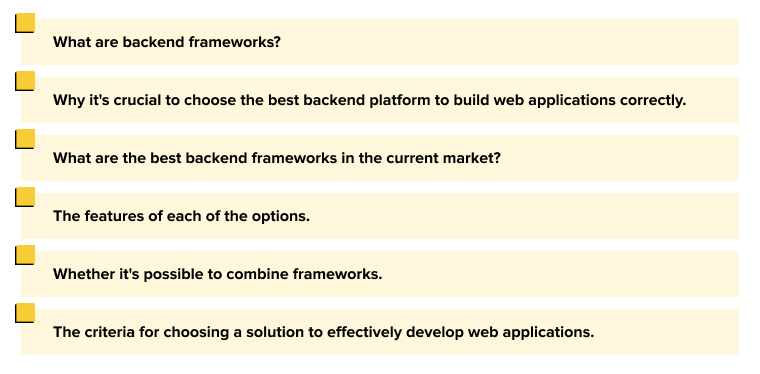
There's plenty of interesting content here, so make yourself comfortable, and we'll start with the key thesis of the article.
Importance of Backend Frameworks in Software Development
The server side, the engine, and the program's core describe the backend IT solution. This element is hidden from the user's view, but almost all operational functionality interacts with it, at least in terms of data exchange between the UI and the database.
Typical app development starts with the software layout and its business logic. Based on this, technologies are chosen for the front end and back end.
The best framework for backend is chosen depending on the tasks and specifics of the future IT solution.
In general, this component has an impact on:
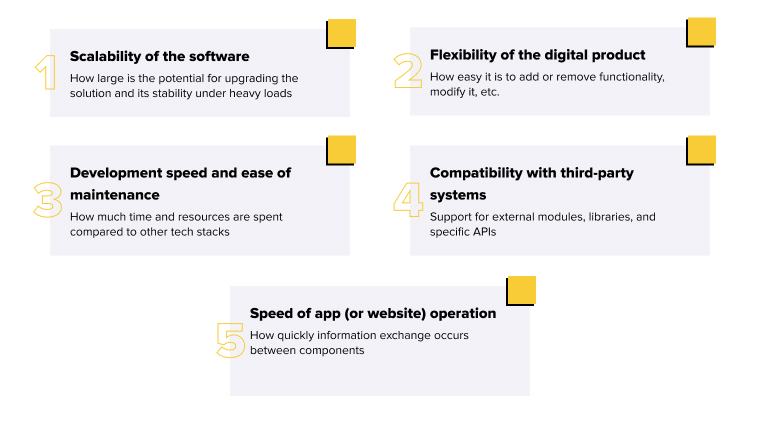
The list provided simultaneously serves as reasons to carefully choose the best frameworks for backend development rather than using widely advertised or "one-size-fits-all" solutions.
Next, we will look at several typical frameworks for backend and their features, preferred application directions, and more.
Django

Another Open Source Framework (OSF) in the selection of the best backend for web development. In short, this is a Python-based web framework that enables rapid development of server-side web applications.
At its core, it follows the MVT (model-view-template) architecture, which allows for a convenient division of IT products into components and their management. Moreover, it employs the "DRY" (Don't Repeat Yourself) principle, which accelerates the process of creating digital applications and helps maintain clean code.
However, Django is not without its flaws. It operates slower than some other similar solutions, somewhat restricts developers, and requires adherence to a specific code format. It may not be ideal for beginners either, as it has a higher complexity level than other syntaxes and environments.
Based on survey results from professionals, the framework has a rating of 14.65%.
Features
There are plenty of features here. For example:
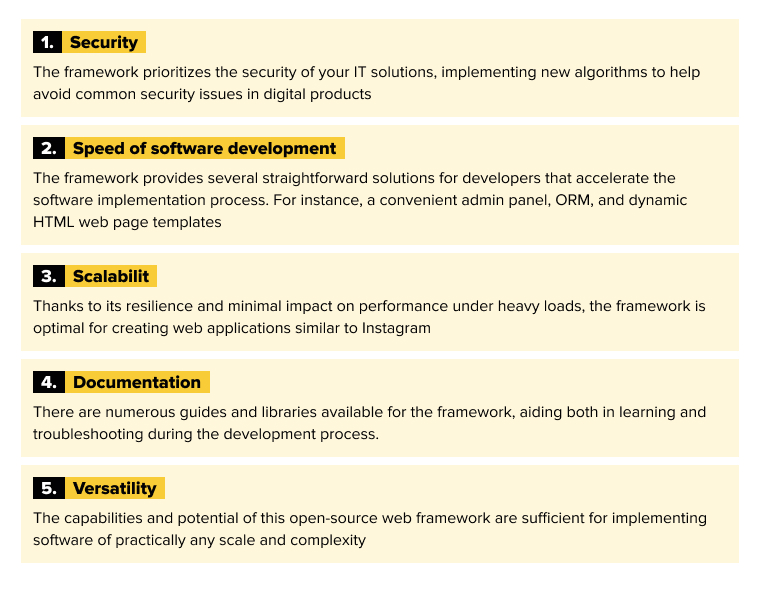
With this list of features (and advantages), even world-renowned brands that choose Django for their web services and products agree.
What Is This Solution Suitable For?
Typically, it is used to create applications and fully-fledged platforms capable of handling significant loads.
This framework can be found in the tech stacks of well-known international brands, including:
Instagram
Pinterest
Spotify
The Washington Post
Mozilla
Disqus
Bitbucket
Notice that all the IT systems mentioned here are large-scale and serve hundreds of thousands, if not millions, of users daily. This reaffirms the effectiveness of Django for such types of digital solutions.
Ruby on Rails
-6e88f8b6.png)
This solution is one of the best backend for web application. It's a popular framework known for its convenience, scalability, and almost universal applicability. With RoR (Ruby on Rails), you can create small, dynamic web products for personal use and full-fledged corporate systems.
RoR uses the Ruby programming language and incorporates concepts such as ORM, CRUD, MVC, DRY, and COC, making the framework even more efficient for professionals.
By the way, only 5.83% of survey respondents actively use it.
Features
Among the features and advantages of RoR are:
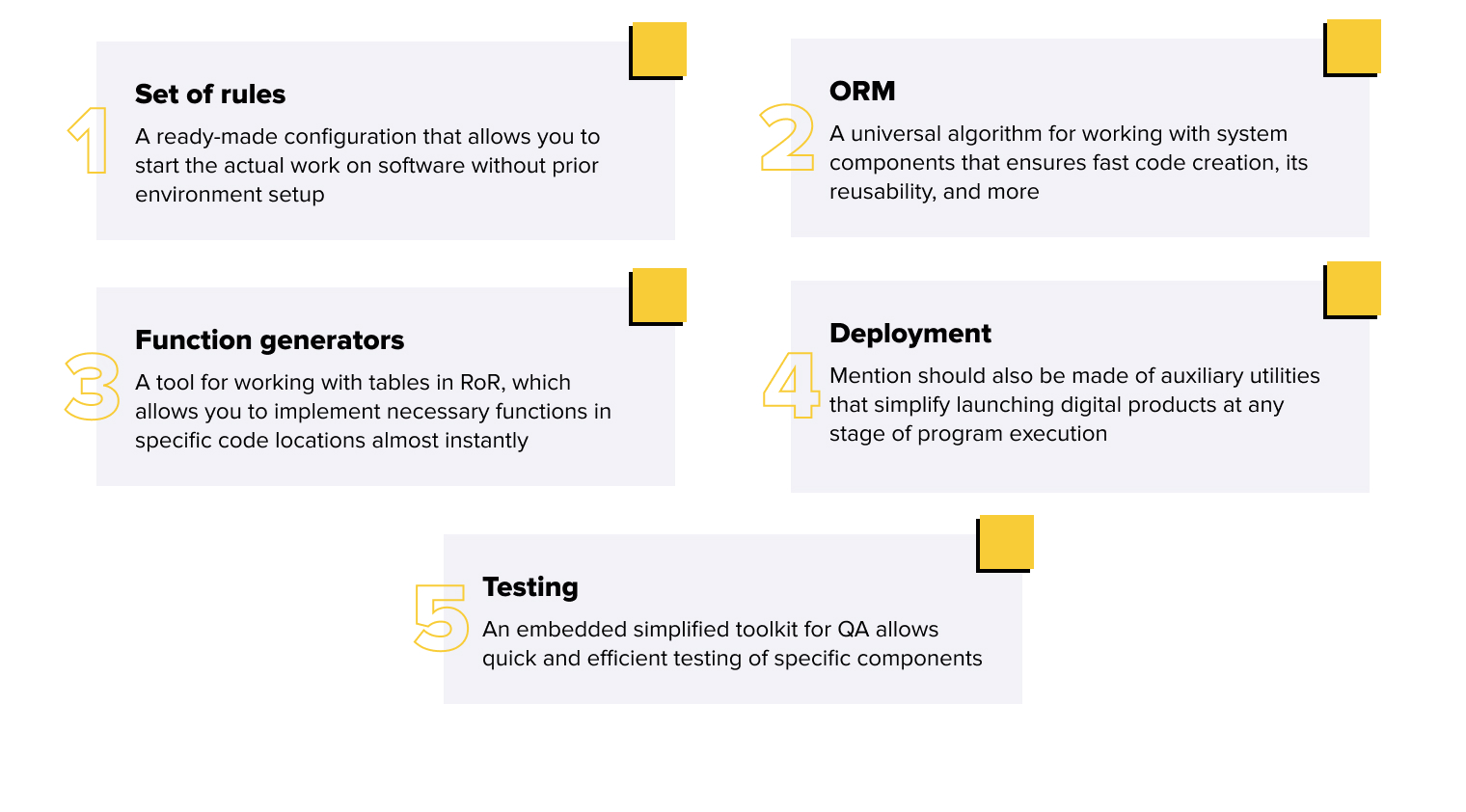
This list of features does not end there, as RoR has a powerful user base that regularly implements extensions and libraries with new functionality.
What Is This Solution Suitable For?
Among the active users of this framework, you'll find some well-known brands such as:
Airbnb
Basecamp
GitHub
Shopify
Twitter
Yellow Pages
Their interactive web applications and websites operate on this technology. Do you need any more convincing that RoR is a highly scalable and effective solution for software development?
Express.js
-06d19674.png)
Exclusively a server-side framework based on Node.js. Perhaps it's even the best API backend from the current rating. This solution has substantial audience support and is periodically recognized as the best in its class.
Unlike other representatives in this segment, it can work with third-party libraries and extensions almost at the native level. It stands out for its flexibility and additional tools, which help minimize errors in code.
Approximately 22.99% of respondents work specifically with this framework.
Features
Some noteworthy aspects for the industry include:

Pretty good features, wouldn't you say? Another interesting advantage is that the framework is an extended version of its predecessor, making it easy to handle similar tasks.
What Is This Solution Suitable For?
If the practices of brands like Myntra, Accenture, Uber, MuleSoft, MySpace, or IBM aren't convincing enough, let's put it this way: this framework is suitable for:
Web servers
APIs
Content management systems (CMS)
E-commerce websites
Social networking sites
Chat apps
Real-time applications
Laravel
-687a7b1e.png)
Who hasn't heard of the top framework for launching blogs and e-commerce websites based on PHP? This solution allows you to implement a basic CMS in a relatively short amount of time and then scale it as needed. But the advantages don't stop there.
The framework has powerful potential, providing convenient and reliable access to databases, a high level of security, and distribution under the MIT license. A large user base continually updates the solution and adapts it to the market's growing needs.
By the way, according to the survey data, 9.45% of respondents use the framework regularly, which is quite a good indicator.
Features
Some of the strengths of this solution include:

And if that's not enough for you, know that this framework is a powerful and versatile solution suitable for implementing IT products of various scales and complexities.
What Is This Solution Suitable For?
Industry leaders like Pfizer, BBC, 9GAG, Invoice Ninja, Alison, and MyRank use this framework in their digital products. Therefore, it is suitable for creating:
Highly scalable systems.
Corporate and non-corporate websites.
Flexible software for different operating systems.
Web applications of varying complexity.
Digital solutions for businesses.
This is by no means an exhaustive list of possible applications for the framework. Want to learn more? Ask the experts at Lampa Software!
Spring Boot
-2293bf1b.png)
Need corporate software with advanced business capabilities? You've found the perfect candidate to build it upon. This framework is a modified version of its namesake predecessor, preserving all its advantages and offering some additional ones.
For example, seamless work with microservices, easy creation of business logic, and a flexible template system. Plus, it's distributed under a free license.
In addition to its strengths, the solution has some drawbacks, such as relatively high resource consumption, resulting in lower software performance. A learning curve might also deter those unfamiliar with the framework. The latter limitation manifests in the limited choice of structure design, which professionals can perceive negatively.
Features
Let's take a look at the advantages of this framework, and there are quite a few:

Accordingly, this framework is quite an effective solution for creating scalable and fast web apps or microservices.
What Is This Solution Suitable For?
Among the key application areas, the most prominent include:
Web applications
APIs
Microservices
Batch processing applications
Command-line applications
Desktop applications
This framework has almost unlimited potential for various usage segments, although it is commonly utilized for enterprise-level software development.
Fast API
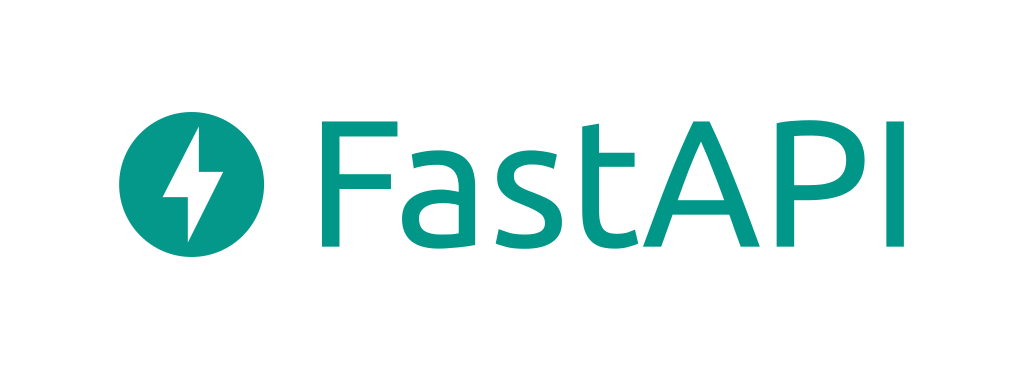
Perhaps the leading contender for the role of the best backend API framework. Despite its size, this compact web development solution has considerable potential, especially when a fast and high-quality tool is required.
It uses Python as the primary programming syntax and natively supports a wide variety of popular databases. It's also a free and reliable solution developed by the community. By the way, it prioritizes software security, offering modern data and connection protection methods.
It's quite popular among developers, as evidenced by the survey in which the framework garnered 6.02% of the votes.
Features
Among the features, the most interesting ones include:

It's essential to note that despite its size and limitations, the framework has a demand in the market as one of the most affordable and efficient solutions for working on software of almost any type and scale.
What Is This Solution Suitable For?
Since it's a highly dynamic technology with high modularity, its application sphere is accordingly diverse, including:
Web applications
APIs
Microservices
Single-page applications (SPAs)
Chat applications
Streaming services
Command-line tools
Despite its limitations and certain challenges, the framework is used by market leaders such as Reddit, MIT, Netflix, Lyft, Samsung, Uber, Zalando, Airbnb, Lyft, Teradata, and Trivago.
ASP.NET Core
-b76e3ab6.png)
This is a versatile frontend and backend solution positioned as a top framework for developing desktop software (Windows, Linux, macOS). Modularity, scalability, a solid codebase, robust support, open-source, and free distribution characterize this framework as a powerful development tool.
Among experts, over 18.59% consider it the best choice for their work.
However, like other similar solutions, it has certain limitations. Firstly, it has a steep learning curve, as it uses C# syntax and .NET Framework modules. Additionally, it requires a deep understanding of MVC and API design.
Features
Do you know why this solution is a candidate for the title of the best backend framework for web development? There are several reasons, or rather, features:

In conclusion, this platform is versatile and reliable, albeit somewhat complex.
What Is This Solution Suitable For?
Based on the framework, you can implement the following types of products:
Web applications
APIs
Microservices
Single-page applications (SPAs)
Chat applications
Streaming services
Command-line tools
Desktop applications
Moreover, it has gained the trust of well-known brands like Alibaba Travels, ViaVarejo, LiteTube, Slack, MasterCard, ROBLOX, accuRx.
Play Framework
-a138e436.png)
This powerful and flexible solution can be used for developing web apps of various types and scales. It has a robust toolkit, quality documentation, and community support.
Additionally, the platform is quite popular among businesses that provide digital services, such as streaming, communication, content sharing, and more.
Features
The solution's features include:

Therefore, this is one of the most versatile and user-friendly frameworks.
What Is This Solution Suitable For?
The platform is most commonly used for implementing:
Web applications
APIs
Microservices
Single-page applications (SPAs)
Chat applications
Streaming services
Command-line tools
Desktop applications
By the way, well-known brands like Coursera, HuffPost, Hootsuite, Janrain, LinkedIn, and Connectifier use this solution.
Conclusion
The list provided here is not final. These are just examples, among which each framework for backend is, to some extent, the best in its class. Each is optimal for performing specific tasks and has the potential for a certain segment of software.
Please note that it's impossible to choose a framework at random. To do this, you need to understand, at a minimum, the concept and, ideally, all the specifications and business logic of your future software.
If you want to select the perfect tech stack for your product but don't know how to do it, trust the professionals. Delegate the project to Lampa Software experts and receive not just consultation but a turnkey solution!